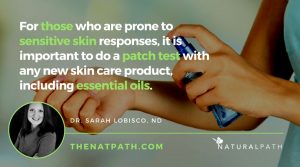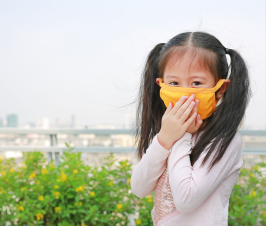Allergies and Essential Oils
 In Part I, I discussed the complexity of the question, “can someone be allergic to essential oils?” In it, I got you up-to-date on the properties of essential oils and various factors that could possibly cause an unwanted hypersensitivity response mediated by the immune system. I also delved deeper into the “what” would cause one to have these unwelcome reactions. I noted the difference between a true allergy and the type IV, delayed hypersensitivity reaction that occurs with essential oil.
In Part I, I discussed the complexity of the question, “can someone be allergic to essential oils?” In it, I got you up-to-date on the properties of essential oils and various factors that could possibly cause an unwanted hypersensitivity response mediated by the immune system. I also delved deeper into the “what” would cause one to have these unwelcome reactions. I noted the difference between a true allergy and the type IV, delayed hypersensitivity reaction that occurs with essential oil.
Here is a brief explanation of a true allergy:
Allergy is one of a class of immune system responses that are termedhypersensitivity reactions. These are harmful immune responses that produce tissue injury and may cause serious disease. Hypersensitivity reactions were classified into four types by Coombs and Gell (Fig. 12.2). Allergy is often equated with type I hypersensitivity (immediate-type hypersensitivity reactions mediated byIgE), and will be used in this sense here.1
As I noted in Part I, essential oils have only been linked to type IV, delayed hypersensitivity reactions (cell-mediated), related to their constituents being classified as haptens. In other words, essential oils are not antigenic themselves, but the compounds they contain do have the ability to attach to proteins or other allergic molecules that could contribute to an allergic response over time (a “delayed” reaction).”
Now, let’s continue on with the discussion on what factors may make someone have a negative reaction to an essential oil.
Why Do Some People Respond With an Allergy?
Remember, an allergen by definition is harmless, it’s the person’s immune system response to it that is abnormal. It is often related to a genetic cause. According to Medscape:
The allergic reaction first requires sensitization to a specific allergen and occurs in genetically predisposed individuals. The allergen is either inhaled or ingested and is then processed by an antigen-presenting cell (APC), such as a dendritic cell, macrophage, or B-cell.[7,8]The antigen-presenting cells then migrate to lymph nodes, where they prime naïve TH cells that bear receptors for the specific antigen.2
So, genetics may play a role,3-5 but why do some family members have allergies and others do not? Furthermore, why do substances that trigger allergies vary in families? I discussed this in Part I in relationship to the chemicals found in skin care products mixing with essential oils. This is where environment may be at play in the concept of entopy, which is defined in a 2010 article in Clinical and Experimental Allergyas follows:
While it is now generally accepted that mucosal local IgE has a role in the expression of atopic allergic disease, the concept of ‘local allergy’ in non-atopic subjects has been proposed, with the term ‘entopy’ given to this condition. Although there is increasing evidence supporting this paradigm, entopy is only applicable to a proportion of non-atopic patients, suggesting that other disease mechanisms exist to explain non-atopic disease. This review considers the evidence for local mucosal allergy in atopic and non-atopic individuals with an emphasis on diseases affecting the upper airways and eye.3
Let’s explore more factors in relationship to essential oils with the aim to allow others to enjoy all the wonderful and health-enhancing benefits essential oils have to offer, without negative effects.
Allergies- The Tip of the Iceberg
Some people are born with an anaphylactic response to a triggering allergen from birth. Others are fine with a trigger, and over time, they get “sensitized.” Why? Here’s an excerpt on this “Iceberg Model,” I think is important to reiterate:
The iceberg provides a useful metaphor to understanding how allergies develop. The tip of the iceberg represents the observable clinical traits seen in children, including skin rashes (eczema), vomiting (reflux), runny noses (rhinitis) and coughing (asthma). What lies beneath the surface is a complex matrix of genetic predisposition and resulting immune and metabolic dysregulation, all triggered under certain environmental conditions. These triggers include airborne, food and water contaminants (tobacco smoke, pesticides, heavy metals, pet and pest dander, food allergens), infectious agents (viruses, molds), and stress.(3-8) Under these conditions, cracks in the ice develop, as certain immune cells are over stimulated relative to others, resulting in an imbalance between Th1 dominant and Th2 dominant immune responses.(9) Even prenatal factors (mothers’ nutrition and other environmental exposures) can greatly affect this immune balance, making certain babies more likely to develop allergies than others.(10,11) Perhaps, then, we can intervene prenatally, or even pre-conceptually, to prevent the inevitable sequence of events. Th2 dominance leads to an immune dysregulation marked by a heightened allergic response and a proliferation of inflammatory cellular mediators (e.g. cytokines, interleukins, leukotrienes). Inflammation involves excess mucous production and other clinically-observable phenomena we call “allergies.”4(You can read more of the details here.)
Therefore, allergies and hypersensitivity reactions can be viewed as a combination of genetics, lifestyle, and various environmental triggers.
Regarding essential oils, the following factors which might come into play for skin sensitization and delayed hypersensitivity reactions.
Reasons Why Some May React to Essential Oils
1. | The Sensitive Skin Type
One may simply have a skin condition that triggers hypersensitivity reactions to various substances. For those who are prone to these sensitive skin responses, it is important to do a patch test with any new skin care product, including essential oils. In this scenario, with someone having an increased potential to react to an oil topically, it may be best to inhale them instead. Furthermore, it would also be important to regularly alternate which oils they use, if they do apply the oils to the skin.
Thankfully, many of us have been able to use the same essential oil for years with no issues!
2. | The Detox Factor- It Is REAL!
There’s a controversy in essential oils regarding sensitization and the “detox theory.” Some claim that essential oils are, in fact, only linked to a skin sensitization due to the essential oil triggering an allergy (an immune response). I already discussed that there is more to play than this simple explanation and defined a true allergy above. Still, others claim that any negative response to a pure essential oil is due to the oil detoxifying the cells and the toxins exiting the skin. I believe this may be extreme as noted in factor 1 above. Therefore, the truth probably lies in the middle.
There is evidence that essential oils can, and do, modulate elimination and detoxification. I discuss this here. Also, due to the fact that essential oils drive compounds into our body, modulate detoxification enzymes (biotransformation), and offer antioxidant protection, doesn’t it make sense that these constituents could react to other chemicals or “personal care products” previously applied on the skin? In other words, wouldn’t these protective secondary metabolites do their job of “ridding the toxic compounds on the skin.”
I’ve seen people who stop the use of chemical products with pure essential oils and don’t have a response following this precaution. Of course, it’s better to avoid synthetic personal care products at all!
Another Consideration of the “Detox Response”- Genetic Variances in a Detox Enzyme
This next factor in detoxification is a little, well… involved.
Some people may notice they have a reaction to essential oils high in phenols. This may be linked to metabolite deficiency in sulfation pathway involving the enzyme phenol sulfur-transferase (PST), which breaks down these compounds. PST is also important for detoxifying harmful substances in the body, making some responses to high phenol essential oils a true “detox response.” I go into detail on this topic here, including how to mitigate it.
3.| The Stress Effect and My Story
My story: When I first started with the oils I was in a moldy house, eating processed foods, had horrific acne, I had a “messed up gut” (which was later diagnosed as Celiac Disease), I had chronic back pain, and was overworked and miserable!!
I couldn’t stand the smell of certain oils or apply them without a breakout. I was “toxic.”
As I calmed my immune system, nurtured my body with foods that it needed to run optimally, implemented a mini-cleanse, dealt with my unfortunate mold exposure, looked at my stress response, and calmed inflammation, I can now use all essential oils without a skin response.
So, my own n=1 experiment of stress, toxicity, and skin response was a positive association.
Here are 2 articles to consider with skin health that support my theory:
4. | Photosensitization
Some oils may cause skin discoloration if applied in an area with high sun exposure. I discussed this here and provide a list.
5. | Intact or Non-Intact Mucous Membranes
If your skin is already damaged and you are prone to sensitivity, you want to avoid using harsher oils topically. Click here to see this list of oils.
6. | Indication, Usage, and Quality
Other factors to consider regarding any kind of allergic or unwanted response to an essential oil, including: quality of essential oils, application and dosage, age, the synergism of constituents, and more, can be found under “Children and Safety” and other selected topics on my essential oil database. (I also think this book on Essential Oil Safety, is a good reference.)
Conclusion
As you can see, a few simple questions for a naturopathic doctor who loves essential oils and digging for the cause, can be quite involved. However, it is my intention that by sharing all these factors and discussing the process of hypersensitivity reactions, many can enjoy essential oils annoyance free for years to come.
References
- Janeway CA Jr, Travers P, Walport M, et al. Immunobiology: The Immune System in Health and Disease. 5th edition. New York: Garland Science; 2001. Chapter 12, Allergy and Hypersensitivity. Available from: https://www.ncbi.nlm.nih.gov/books/NBK10756/
- Buelow, B, Kaliner MA, et al. Drugs & Diseases. Allergy & Immunology: Immediate Hypersensitivity Reactions. Medscape: eMedicine. Feb 9, 2015 (updated). http://emedicine.medscape.com/article/136217-overview#a5
- Powe DG, Bonnin AJ, Jones NS. ‘Entopy’: local allergy paradigm. Clin Exp Allergy. 2010 Jul;40(7):987-97. doi: 10.1111/j.1365-2222.2010.03536.x.
- Mayo Clinic. Allergies. Symptoms and Causes. Mayo Foundation for Medical Education and Research (MFMER). 1998-2017. http://www.mayoclinic.org/diseases-conditions/allergies/symptoms-causes/dxc-20270197
- Moreno, MA. Atopic Diseases in Children. JAMA Pediatr. 2016;170(1):96. doi:10.1001/jamapediatrics.2015.3886
- Kresser, C. The gut-skin connection: how altered gut function affects the skin. Chriskresser.com. October 19, 2012.
- Slominski A. A nervous breakdown in the skin: stress and the epidermal barrier. The Journal of Clinical Investigation. 2007;117(11):3166-3169. doi:10.1172/JCI33508.
 SARAH LOBISCO, ND, is a graduate of the University of Bridgeport’s College of Naturopathic Medicine (UBCNM). She is licensed in Vermont as a naturopathic doctor and holds a Bachelor of Psychology from State University of New York at Geneseo.
SARAH LOBISCO, ND, is a graduate of the University of Bridgeport’s College of Naturopathic Medicine (UBCNM). She is licensed in Vermont as a naturopathic doctor and holds a Bachelor of Psychology from State University of New York at Geneseo.
Dr. LoBisco speaks professionally on integrative medical topics, has several journal publications, and has completed her postdoctoral training as a certified functional medicine practitioner. Dr. LoBisco currently incorporates her training in holistic medical practices and conventional medicine through writing, researching, private wellness consultations, and through her independent contracting work for companies regarding supplements, nutraceuticals, essential oils, and medical foods.
Dr. LoBisco also enjoys continuing to educate and empower her readers through her blogs and social media. Her recent blogs about living naturally in our complex world and on the applications of essential oils can be found at www.dr-lobisco.com and at www.saratoga.com/living-well. Her new book BreakFree Medicine is now available on Amazon and Barnes & Noble’s.

















